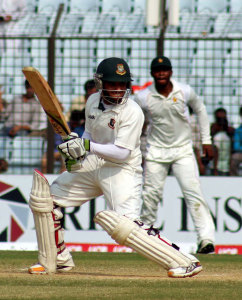A 24-hour transport strike in Chittagong meant that even the small crowds that had turned up on the first four days of the third Test couldn’t make it as far as the Zahur Ahmed Chowdhury Stadium, some seven kilometres to the west of the city centre. So when Shafiul Islam got the last two Zimbabwe wickets, Bangladesh’s most emphatic moment in 14 years of Test cricket was seen by hardly 2,000 people.

After losing his place in the side during the year, Mominul Haque answered his critics by scoring runs heavily © BCB
More cruelly, perhaps, the team was not presented with the series winner’s trophy. The trophy was a regular fixture near the dressing-room steps during the game but had apparently been removed just before the post-match presentation ceremony. News is that it will be presented at the end of the ODI series in Dhaka, on December 1.
To be fair, most champion cricket teams in Bangladesh are used to getting their trophy later. Some years ago, BCB had even held a ceremony to give away trophies of league winners from several seasons prior. The result and the performances of the national side mattered so much to Bangladesh, however, that these supplementary factors were not talked about or given a thought. Given the year they have had before Zimbabwe arrived in Bangladesh in mid-October, the sparse crowd and lack of trophy wouldn’t have mattered.
The win really meant the world to the Bangladesh team. They have very little cricket before the 2015 World Cup, although there are plans to play either in Zimbabwe or the UAE, apart from a few practice matches in Australia in January.
Maybe in February and March this series will hardly be remembered. It takes very little time to forget a great or a terrible performance. Like Mominul Haque, who had batted quite well in the 2013-14 season but became the bane of his team after a single low score against India. He lost his place in the other formats and his ability to play the short ball was questioned for a while. Mominul did, however, reply with the bat in West Indies and then scored more runs back home.
Like Mominul, many of the players who walked off quietly after being greeted by hangers-on in Chittagong would have different stories to tell and, at least for 2014, their stories would have happy endings.
Shakib Al Hasan’s return from suspension, said to be the worst phase of his career, was always going to be received grandly but a performance of 251 runs and 18 wickets was hard to predict. That Tamim Iqbal would score his first hundred in four-and-a-half years and would follow it up with another century was also not expected.
Shakib and Tamim have restored the status quo within the team while Mominul is getting rid of questions about him. Mahmudullah has runs under his belt which is giving him confidence to hit out or stick it out. Mushfiqur Rahim has won enough to achieve numbers he has craved for a long time.
Taijul Islam and Jubair Hossain have not let Bangladesh miss Sohag Gazi or forced the side to look extensively for spinners to back Shakib. Shahadat Hossain, Rubel Hossain and Shafiul Islam have shown glimpses that are much required ahead of tours to countries where pace bowling matters a lot. Mashrafe Mortaza and Al-Amin Hossain are ODI regulars but injuries are never too far from Bangladeshi pace bowlers so it is good to have more men ready.
There will be the argument that their opposition in the Test series were not at their best. It could be argued that Zimbabwe are an ordinary touring team who had come to Bangladesh without Sean Williams. It could also be said that the performances pointed to the overall struggle as a cricketing nation. Before they toured Bangladesh, however, Zimbabwe had beaten Australia and had run South Africa close during the triangular series at home. Prior to this series, they had a 2-1 lead over Bangladesh in three Tests since their readmission in 2011.
There were long periods during this Test series when the level of cricket from both teams left much to be desired. Batsmen from both teams showed an ability to stick for long but sometimes were stuck and could not move forward. The bowlers, however, have been consistent, particularly Zimbabwe’s pacers and Bangladesh’s spinners.
This was only the eighth time Bangladesh took 20 wickets in a Test, and finished the three-match series with all 60 wickets. Perhaps the difference was also among the weak links. While Bangladesh’s seamers were effective in patches and provided breakthroughs, Zimbabwe’s spinners hardly came to the party.
As it ended 3-0 in their favour, however, Bangladesh would not really mind the opponent or their form. They would take the result at any ground, without the presence of spectators and without anything nice written about them. They will take it any way it comes, without the frills. Such has been the famine for a win.
(Taken from ESPNcricinfo, by Mohammad Isam)


